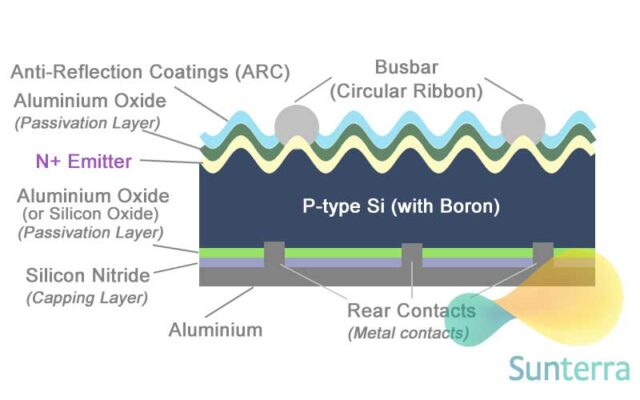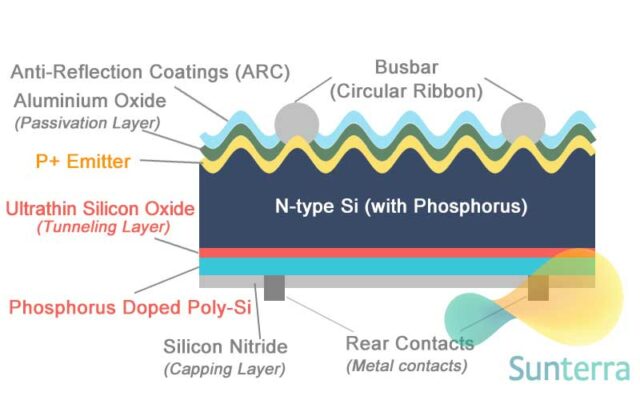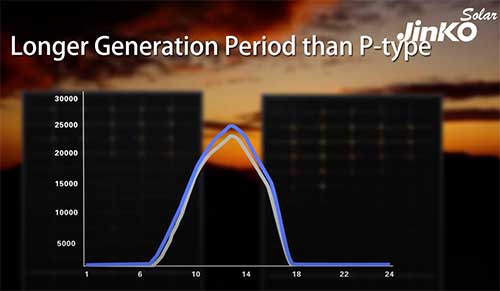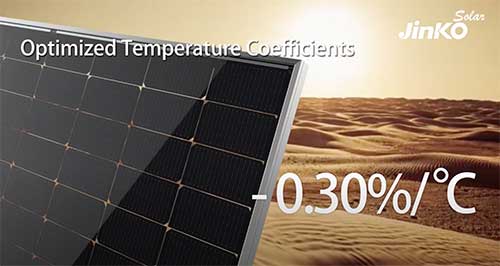We are discussing N-type solar cell following the PERC Solar Panel posted in last article. PERC is a kind of P-type solar cell, and Mono PERC is also a mainstream product in recent years. However, N-type and P-type solar cells are big different in terms of cells structure. Most of people claim that N-type is the future trends. The current representative is TOPCon technology in N-type (Tunnel Oxide Passivated Contact), known as the next generation solar cell technology after PERC.

We generate electrons by hitting silicon atoms with photons from sunlight, which means photoelectric effect. The silicon wafer in these solar cells is not pure silicon. In order to make the cells work, they must be mixed a certain amount of impurities, so that the concentration on both sides of the silicon is different, causing a difference electrical charge when photons hit the cells.
To understand what is the difference between of N-type and P-type, the first thing is to learn about number of electrons.
P-type solar cell dopes the silicon bulk with boron, so it make the cell overall positively charged because boron has one less electron than silicon.


The table 1 shows main difference:
| Cell Type | Silicone Base | Top Silicone Layer | Overall Charged | Popularity |
|---|---|---|---|---|
| P-type | with Boron | N+ Emitter | Positively Charged | Most Common |
| N-type | with Phosphorus | P+ Emitter | Negatively Charged | Future Trends |
The table 2 shows advantages and disadvantages:
| Cell Type | Efficiency | Degradation | Reliability in High Temperature | Cost |
|---|---|---|---|---|
| P-type | lower | affected by LID/LeTID | Easy to lower lifetime of cell | Lower |
| N-type | Higher | Not affected by LID/LeTID | Higher temperature tolerance | Higher |
The main purpose is naturally efficiency.
Only with enduring performance can we always maintain high efficiency.

P-type has boron-oxygen defects. With the long time exposed under sunlight, dissolved oxygen forms a recombination area with the boron. This is called LID (Light Induced Degradation) or LeTID (Light and elevated Temperature Induced Degradation) and seriously affects the efficiency. But in Australia, all PERC panels are require to be certified as LID/LeTID resistant from 2020 for sale.
As a comparison, those silicone with phosphorus don’t need to worry about LID/LeTID deterioration problems since phosphorous silicon can eliminate the sites impurities of boron oxygen. This immunity against LID/LeTID results in a longer carrier lifetime in the cell and a more efficient and powerful system.
Besides, Heat is a solar killer
When it comes to high temperature resistance, P-type is easier to produce metallic impurities such as interstitial iron than N-type resulting in decreasing life expectancy.

N-type is skilled at removing efficiency impact from heat or increased temperature. It has optimised temperature coefficients to around –0.30%/°C

